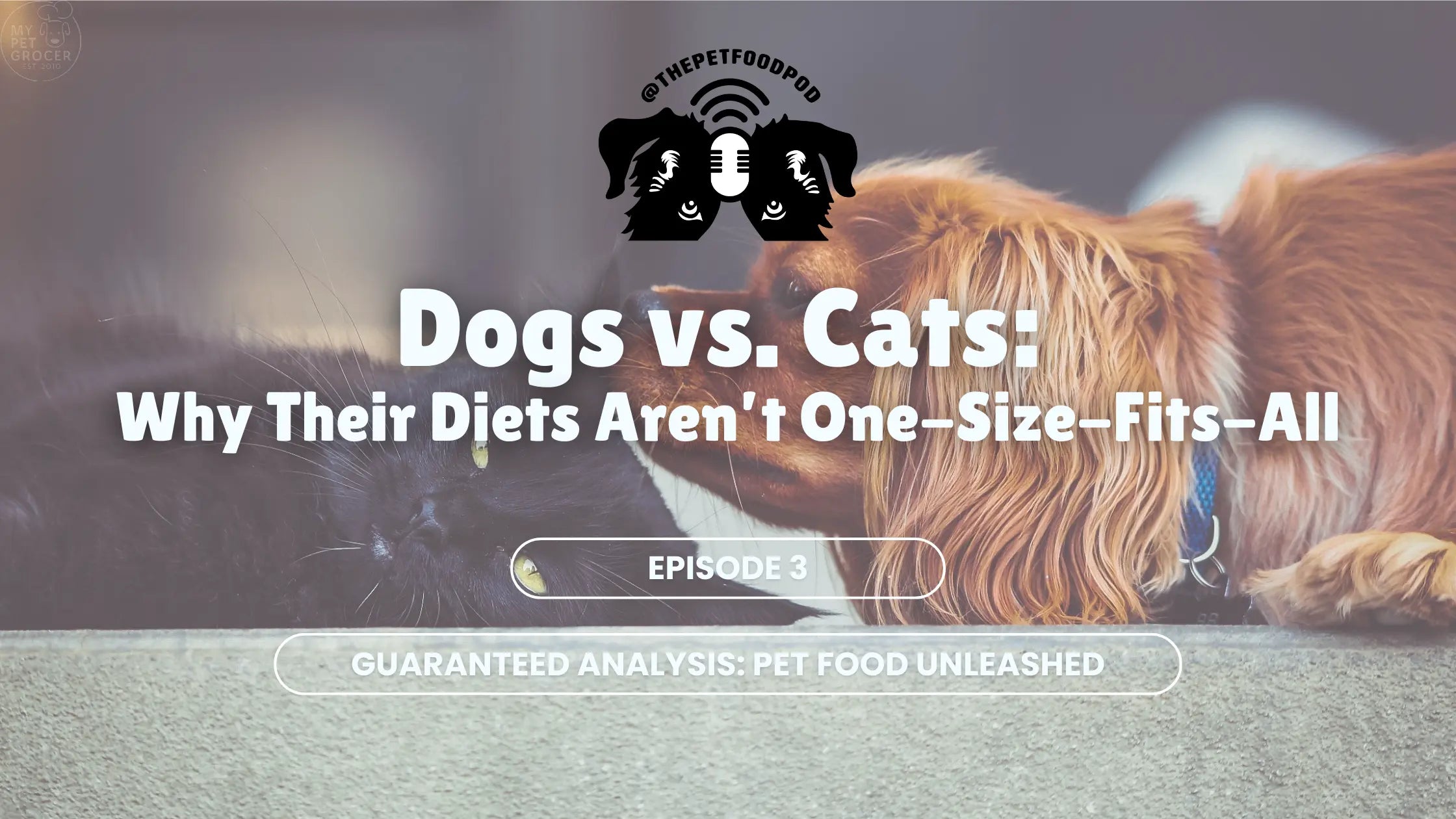
Dogs vs. Cats: Why Their Diets Aren’t One-Size-Fits-All

When it comes to pet nutrition, it’s easy to assume that what’s good for one animal must be good for another. After all, dog food and cat food look pretty similar, right? But in reality, dogs and cats have fundamentally different dietary needs. In the third episode of Guaranteed Analysis, we dive into what makes their nutrition unique, bust common myths, and explore the science behind what (and how) we feed our pets.
Dogs vs. Cats: The Key Differences in Nutrition
1. Essential Amino Acids: What’s Missing?
One of the biggest differences between dog and cat nutrition is their amino acid requirements. Both dogs and cats need more than 30 essential nutrients in their diet, including specific amino acids (the building blocks of protein).
-
Dogs require 10 essential amino acids, which they can synthesize from various food sources.
-
Cats require 11 essential amino acids, with taurine being a crucial one that they must obtain from their diet.
While dogs can produce taurine from other amino acids, cats cannot — meaning that if their diet lacks taurine, they can develop serious health issues, including heart disease and vision problems.
2. Dogs Are Adaptable, Cats Are Not
Dogs are often called adaptive carnivores because they can process a variety of food sources — including some plant-based ingredients. Cats, on the other hand, are obligate carnivores, meaning they must eat meat to survive.
What does this mean in practical terms?
-
Dogs can tolerate a wider range of macronutrients (protein, fat, carbohydrates).
-
Cats need high-protein, high-fat diets and can’t synthesize key nutrients (like vitamin A and arachidonic acid) from plant sources.
-
Feeding a cat a vegetarian or vegan diet is not safe unless meticulously formulated with a veterinary nutritionist.
3. Do Dogs Need Intermittent Fasting?
Intermittent fasting is a hot topic in human nutrition, but should we apply it to our pets? Some studies suggest that fasting could be beneficial for dogs, as their ancestors didn’t eat on a strict schedule. A healthy dog can go up to 48 hours without food without harm.
However, cats are different. Because their metabolism is constantly producing glucose, extended fasting can be dangerous. If a cat goes too long without eating, it can lead to hepatic lipidosis (fatty liver disease), which is potentially fatal.
4. The Wet Food Debate: Do Cats Really Need It?
A common claim is that cats are chronically dehydrated and need wet food to stay healthy. While it’s true that cats evolved as desert animals and may not have a strong thirst drive, research shows that healthy cats will seek out water when needed.
Wet food can be beneficial for:
✔️ Cats prone to urinary issues (like blockages or kidney disease).
✔️ Cats who don’t drink enough water on their own.
✔️ Encouraging picky eaters with different textures and flavors.
But forcing every cat to eat only wet food? That’s not necessary — and some veterinarians even find this belief harmful, as it can discourage owners from feeding a well-balanced dry food when needed.
5. Rotating Foods: Good or Bad?
Some pet food brands encourage feeding the same formula for life, while others promote rotating diets to “prevent allergies” or improve health. So, what’s the truth?
-
Rotating food brands can provide variety in nutrient profiles and expose pets to different ingredient formulations.
-
Switching proteins (like chicken, beef, or fish) can be helpful — but exotic or novel proteins should be saved in case a pet develops food allergies later.
-
There’s no scientific evidence that rotating diets prevents allergies, but it can help prevent picky eating and food boredom.
For cats, early exposure to different textures (canned, kibble, freeze-dried, homemade) can help prevent food aversions later in life.
6. The Science of Pet Food: Testing Matters
One of the most important (yet overlooked) aspects of pet food is how it’s tested. Many brands market their food as “complete and balanced,” but have they actually tested it on real pets?
-
Feeding Trials: High-quality brands conduct trials where they feed real dogs and cats their food and monitor their health.
-
Digestibility Studies: These measure how well pets absorb nutrients from their food.
-
Bioavailability Testing: Looks at whether pets actually use the nutrients provided in the food.
Some trendy diets — like vegan cat food — may look balanced on paper, but without real-world feeding trials, we have no way of knowing if cats can actually digest and use the nutrients properly.
Final Takeaways
Dogs and cats have different nutritional needs, and understanding those differences helps us make better choices for their health.
🐾 Dogs are more flexible eaters, while cats are strict carnivores.
🐾 Taurine, vitamin A, and fatty acids are critical for cats.
🐾 Intermittent fasting is fine for dogs — but risky for cats.
🐾 Wet food is helpful for some cats, but not mandatory for all.
🐾 Rotating foods can be beneficial, but not for allergy prevention.
🐾 Feeding trials and testing matter when choosing pet food.
Want to learn more? Listen to the full episode of Guaranteed Analysis and join us as we dive deeper into the science behind pet food!